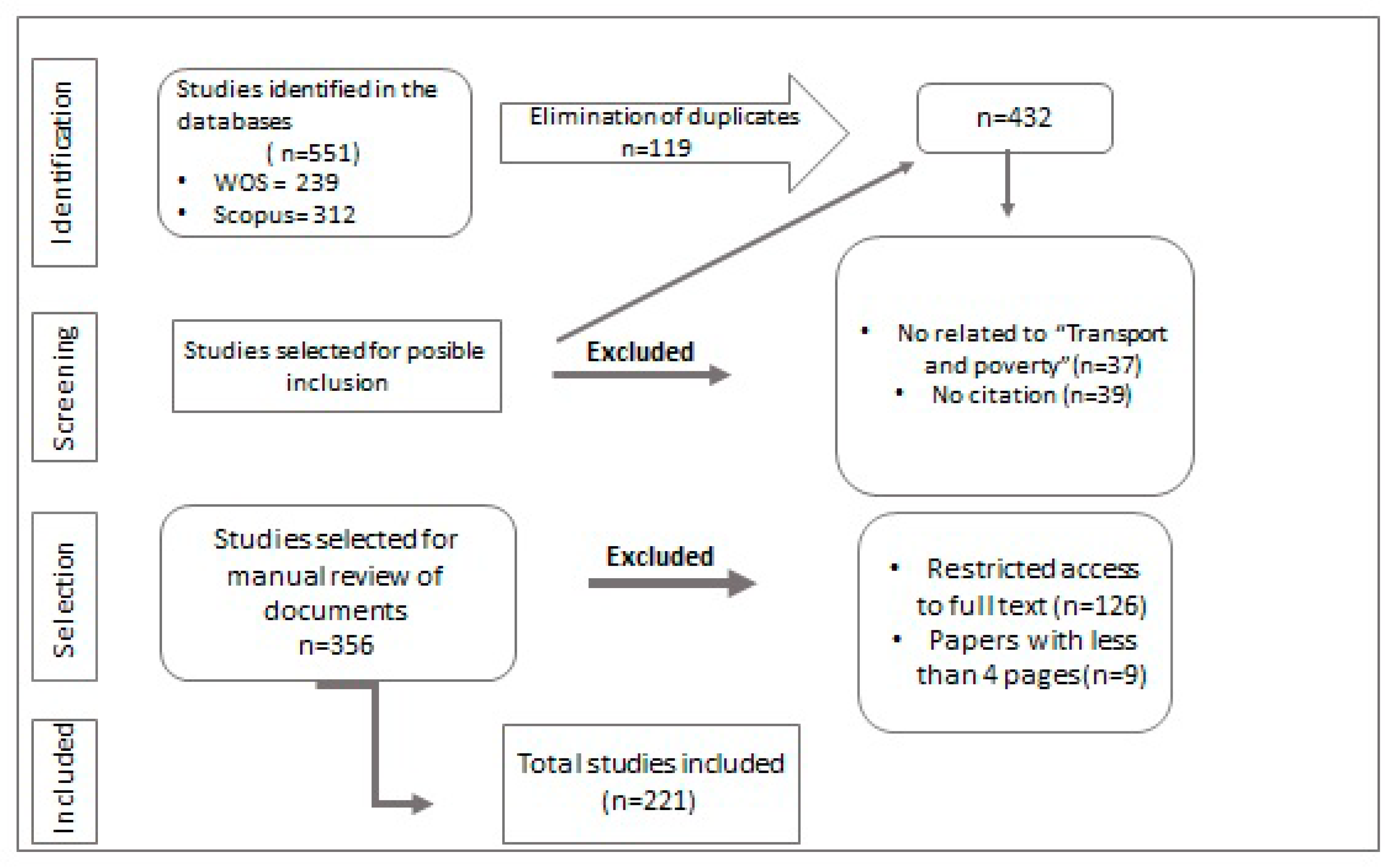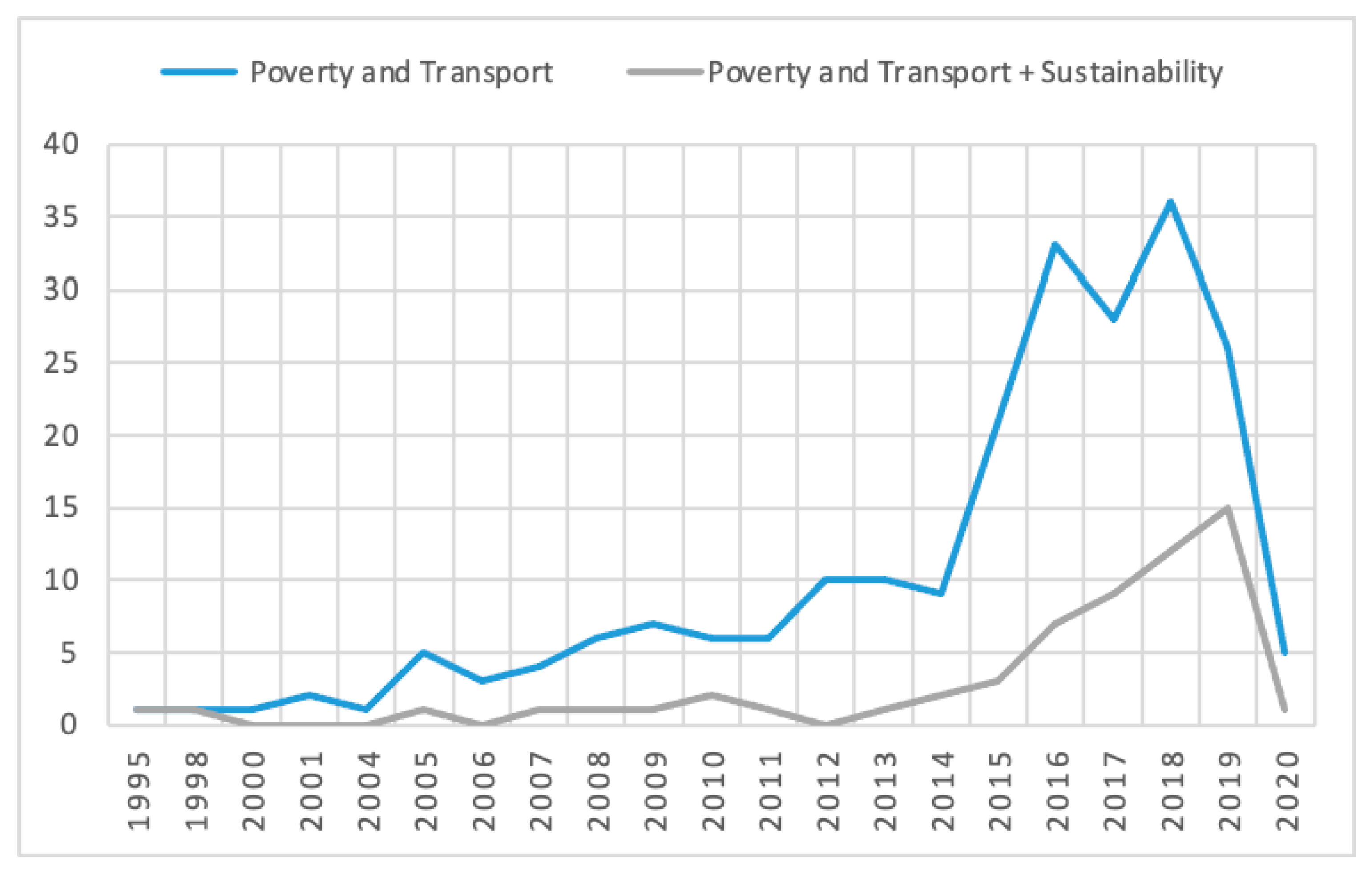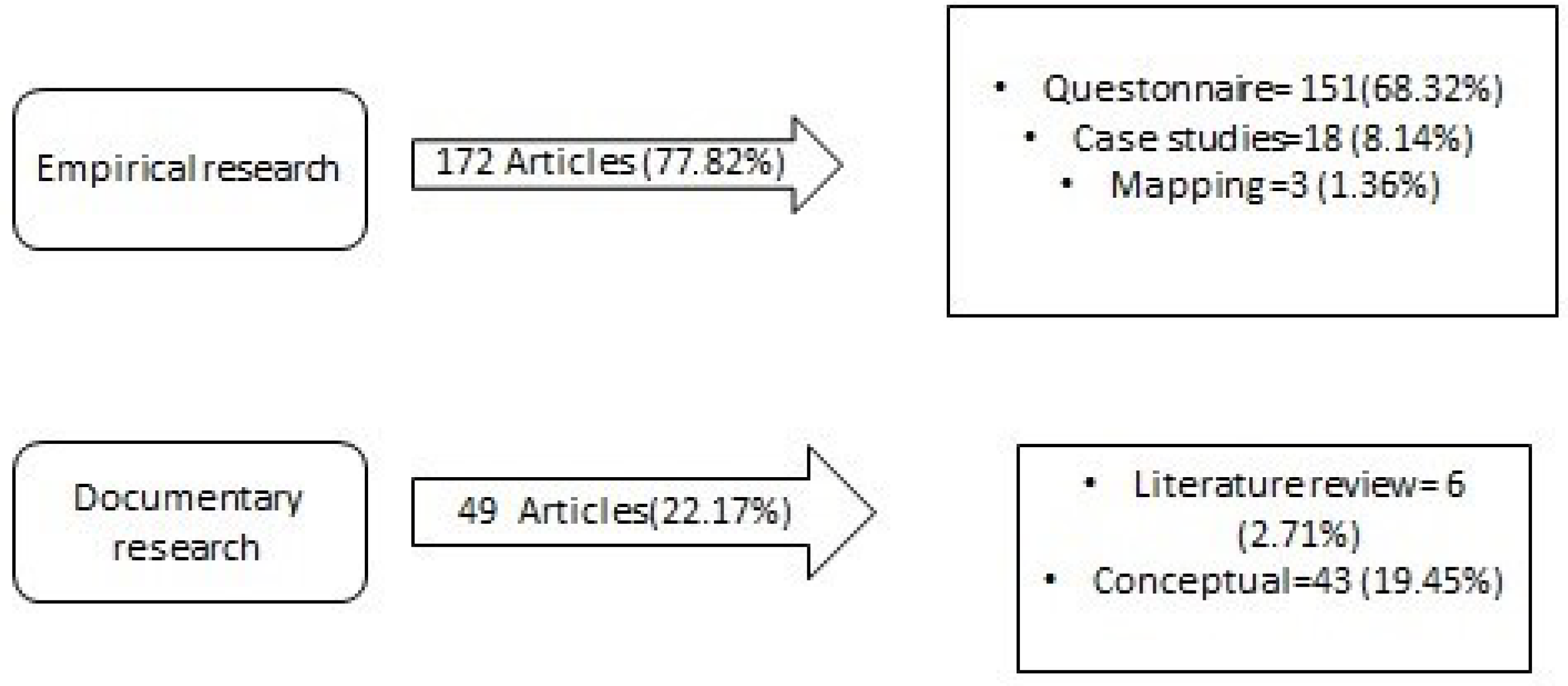Transport Poverty with Special Reference to Sustainability: A Systematic Review of the Literature
Abstract
1. Introduction
Relationship between Transport Poverty and Sustainability
2. Materials and Methods
- Phase 1: Identification of research questions
- Phase 2: Search strategy
- Phase 3: Procedure for the selection of the articles.
3. Results
3.1. Number of Publications per Year
3.2. Publications by Scientific Journals
3.3. Publications by Country and University
3.4. Publications by Field of Knowledge
3.5. Type of Study
3.6. Publications by Author and Relevance of Articles
4. Discussion
5. Conclusions
Author Contributions
Funding
Institutional Review Board Statement
Informed Consent Statement
Data Availability Statement
Conflicts of Interest
References
- Jiang, L.; Wen, H.; Qi, W. Sizing up Transport Poverty Alleviation: A Structural Equation Modeling Emprical Analysis. J. Adv. Transp. 2020, 2020, 8835514. [Google Scholar] [CrossRef]
- Banco Mundial. Medio Ambiente. Available online: https://www.bancomundial.org/es/topic/environment/overview (accessed on 20 November 2020).
- Metta, P. Transport Poverty in Thailand: Concept, Measurement and Data Availability. Int. Rev. Spat. Plan. Sustain. Dev. 2020, 8, 70–85. [Google Scholar] [CrossRef]
- Mattioli, G.; Lucas, K.; Marsden, G. Transport Poverty and Fuel Poverty in the UK: From Analogy to Comparison. Transp. Policy 2017, 59, 93–105. [Google Scholar] [CrossRef]
- Titheridge, H.; Oviedo, D.; Hernandez, R.; Ye, N.C.; Mackett, R. Transport Poverty: Concepts, Measurement and Policy Perspectives. In Proceedings of the Association of American Geographers’ Annual Meeting, Tampa, FL, USA, 8 April 2014. [Google Scholar]
- Lucas, K.; Mattioli, G.; Verlinghieri, E.; Guzman, A. Transport Poverty and Its Adverse Social Consequences. In Proceedings of the Institution of Civil Engineers-Transport; Thomas Telford Ltd.: Londres, Reino Unido, 2016; Volume 169, pp. 353–365. [Google Scholar] [CrossRef]
- Martens, K.; Bastiaanssen, J. An index to Measure Accessibility Poverty Risk. In Measuring Transport Equity; Elsevier: Amsterdam, The Netherlands, 2019; pp. 39–55. [Google Scholar] [CrossRef]
- Delmelle, E.; Casas, I. Evaluating the Spatial Equity of Bus Rapid TransitBased Accessibility Patterns in a Developing Country: The Case of Cali, Colombia. Transp. Policy 2012, 20, 36–46. [Google Scholar] [CrossRef]
- Churchill, S.A. Ethnic diversity and transport poverty. Transp. Res. Part A Policy Pract. 2020, 139, 297–309. [Google Scholar] [CrossRef]
- Gandelman, N.; Serebrisky, T.; Suárez-Alemán, A. Household Spending on Transport in Latin America and the Caribbean: A Dimension of Transport Affordability in the Region. J. Trans. Geogr. 2019, 79, 102–482. [Google Scholar] [CrossRef]
- Bergman, Z.; Bergman, M. A Case Study of the Sustainable Mobility Problem–Solution Paradox: Motility and Access of Metrorail Commuters in the Western Cape. Sustainability 2019, 11, 2842. [Google Scholar] [CrossRef]
- Bhan, N.; Madhira, P.; Muralidharan, A.; Kulkarni, B.; Murthy, G.V.; Basu, S.; Kinra, S. Health needs, access to healthcare, and perceptions of ageing in an urbanizing community in India: A qualitative study. BMC Geriatr. 2017, 17156. [Google Scholar] [CrossRef]
- Agyemang-Duah, W.; Mensah, C.M.; Peprah, P.; Arthur, F.; Abalo, E.M. Facilitators of and barriers to the use of healthcare services from a user and provider perspective in Ejisu-Juaben municipality, Ghana. J. Public Health 2019, 27, 133–142. [Google Scholar] [CrossRef]
- Hussain, R.; Rashidian, A.; Hafeez, A.; Mirzaee, N. Factors influencing healthcare seeking behaviour at primary healthcare level, in Pakistan. J. Ayub Med. Coll. Abbottabad 2019, 31, 201–206. [Google Scholar]
- Alzubaidi, H.; Namara, K.; Browning, C.; Marriott, J. Barriers and enablers to healthcare access and use among Arabic-speaking and Caucasian English-speaking patients with type 2 diabetes mellitus: A qualitative comparative study. BMJ Open 2015, 5. [Google Scholar] [CrossRef] [PubMed]
- Chouler, J.; Cruz-Izquierdo, Á.; Rengaraj, S.; Scott, J.L.; Di Lorenzo, M. A screen-printed paper microbial fuel cell biosensor for detection of toxic compounds in water. Biosens. Bioelectron. 2018, 102, 49–56. [Google Scholar] [CrossRef] [PubMed]
- Colenbrander, S.; Gouldson, A.; Roy, J.; Kerr, N.; Sarkar, S.; Hall, S.; Mcanulla, F. Can low-carbon urban development be pro-poor? The case of Kolkata, India. Environ. Urban 2017, 29, 139–158. [Google Scholar] [CrossRef]
- Provencio, E. Comisión Mundial Del Medio Ambiente y Del Desarrollo; Alianza, M., Ed.; World Commission on Environment and Development: Madrid, Spain, 1998. [Google Scholar]
- Zarta, P. La sustentabilidad o sostenibilidad: Un concepto poderoso para la humanidad. Tabula Rasa 2018, 28, 409–423. [Google Scholar] [CrossRef]
- Mérida-Mártinez, Y.; Acuña-Gamboa, L.A. Pobreza en México: Factor de vulnerabilidad para enfrentar los efectos de cambio climático. Revista Iberoamericana Bioeconomía Cambio Climático 2016, 1, 2. [Google Scholar] [CrossRef]
- Adeel, M.; Yeh, A.G.O.; Zhang, F. Transportation disadvantage and activity participation in the cities of Rawalpindi and Islamabad, Pakistan. Transp. Policy 2016, 47, 1–12. [Google Scholar] [CrossRef]
- Bennis, I.; De Brouwere, V. Fee exemption for caesarean section in Morocco. Arch. Public Health 2012, 70, 3. [Google Scholar] [CrossRef]
- Sustrans. Transport Poverty in Scotland. Available online: https://www.sustrans.org.uk/media/2880/transport_poverty_in_scotland_2016.pdf (accessed on 20 November 2020).
- Manterola, C.; Astudillo, P.; Arias, E.; Claros, N.; Mincir, G. Revisiones sistemáticas de la literatura. Qué se debe saber acerca de ellas. Cirugía Española 2013, 91, 149–155. [Google Scholar] [CrossRef]
- Martín-Navarro, A.; Sancho, M.P.L.; Medina-Garrido, J.A. BPMS para la gestión: Una revisión sistemática de la literatura. Revista Española Documentación Científica 2018, 41, 213. [Google Scholar] [CrossRef]
- Beltrán, G.; Óscar, A. Revisiones sistemáticas de la literatura. Rev. Colomb. Gastroenterol. 2005, 20, 60–69. [Google Scholar]
- Díaz-Iso, A.; Eizaguirre, A.; García-Olalla, A.M. Una revisión sistemática del concepto de actividad extracurricular en Educación Superior. Educación XX1 Revista Facultad Educación 2020, 23. [Google Scholar] [CrossRef]
- Sánchez, L.; Blanco, B. Análisis de la producción científica hispana en mejora continua: 1990–2011. Revista Española Documentación Científica 2016, 39, 116. [Google Scholar] [CrossRef]
- Wen, J.; Li, S.; Lin, Z.; Hu, Y.; Huang, C. Systematic literature review of machine learning based software development effort estimation models. Inf. Softw. Technol. 2012, 54, 41–59. [Google Scholar] [CrossRef]
- Urrútia, G.; Bonfill, X. Declaración PRISMA: Una propuesta para mejorar la publicación de revisiones sistemáticas y metaanálisis. Med. Clin. 2010, 135, 507–511. [Google Scholar] [CrossRef]
- Mainardi, C.F.; Suárez, M.A.M. La responsabilidad social corporativa (rsc) en las bases de datos scopus y wos (estudio bibliométrico). EDICIC 2011, 1, 141–160. [Google Scholar]
- Echeverri, D.R.C.; Cruz, R.Z. Revisión de instrumentos de evaluación de clima organizacional. Estud. Gerenc. 2014, 30, 184–189. [Google Scholar] [CrossRef]
- David, R.J.; Han, S.-K. A systematic assessment of the empirical support for transaction cost economics. Strateg. Manag. J. 2004, 25, 39–58. [Google Scholar] [CrossRef]
- Guinea, A.S.; Nain, G.; Le Traon, Y. A systematic review on the engineering of software for ubiquitous systems. J. Syst. Softw. 2016, 118, 251–276. [Google Scholar] [CrossRef]
- Kitchenham, B.; Brereton, P. A systematic review of systematic review process research in software engineering. Inf. Softw. Technol. 2013, 55, 2049–2075. [Google Scholar] [CrossRef]
- Salvador-Oliván, J.A.; Marco-Cuenca, G.; Arquero-Avilés, R. Las revisiones sistemáticas en Biblioteconomía y Documentación: Análisis y evaluación del proceso de búsqueda. Revista Española Documentación Científica 2018, 41, 207. [Google Scholar] [CrossRef]
- Thomé, A.M.T.; Scavarda, A.; Ceryno, P.S.; Remmen, A. Sustainable new product development: A longitudinal review. Clean Techno. Environ. Policy 2016, 18, 2195–2208. [Google Scholar] [CrossRef]
- Eurostat. People at Risk of Poverty or Social Exclusión. Available online: http://bit.ly/3mBDewO (accessed on 20 November 2020).
- Bhosale, V.A.; Kant, R. Metadata analysis of knowledge management in supply chain. Bus. Process Manag. J. 2016, 22, 140–172. [Google Scholar] [CrossRef]
- Krull, G.; Duart, J. Research Trends in Mobile Learning in Higher Education: A Systematic Review of Articles (2011–2015). Int. Rev. Res. Open Distrib. Learn. 2017, 18. [Google Scholar] [CrossRef]
- Kim-Soon, N.; Ibrahim, M.A.; Razzaly, W.; Ahmad, A.R.; Sirisa, N.M.X. Mobile technology for learning satisfaction among students at Malaysian technical universities (MTUN). Adv. Sci. Lett. 2017, 23, 223–226. [Google Scholar] [CrossRef]
- Saroia, A.I.; Gao, S. Investigating university students’ intention to use mobile learning management systems in Sweden. Innov. Educ. Teach. Int. 2019, 56, 569–580. [Google Scholar] [CrossRef]
- Sepulveda, E.; Quintana, M.G.B.; Butter, M.C. Mobile Devices for Teaching English as a Second Language in Higher Education, the Case of DUOC in Chile. J. Mob. Multimed. 2014, 10, 234–243. [Google Scholar]
- Gasaymeh, A.-M.; Aldalalah, O.M. The Impact of Using SMS as Learning Support Tool on Students’ Learning. Int. Educ. Stud. 2013, 6. [Google Scholar] [CrossRef]
- Ayieko, J.; Brown, L.; Anthierens, S.; Van Rie, A.; Getahun, M.; Charlebois, E.D.; Petersen, M.L.; Clark, T.D.; Kamya, M.R.; Cohen, C.R.; et al. Hurdles on the path to 90-90-90 and beyond: Qualitative analysis of barriers to engagement in HIV care among individuals in rural East Africa in the context of test-and-treat. PLoS ONE 2018, 13, e0202990. [Google Scholar] [CrossRef]
- Azia, I.N.; Mukumbang, F.C.; Van Wyk, B. Barriers to adherence to antiretroviral treatment in a regional hospital in Vredenburg, Western Cape, South Africa. South. Afr. J. HIV Med. 2016, 17. [Google Scholar] [CrossRef]
- Barennes, H.; Frichittavong, A.; Gripenberg, M.; Koffi, P. Evidence of high out of pocket spending for HIV care leading to catastrophic expenditure for affected patients in Lao People’s Democratic Republic. PLoS ONE 2015, 10, e0136664. [Google Scholar] [CrossRef]
- Braathen, S.H.; Sanudi, L.; Swartz, L.; Jürgens, T.; Banda, H.T.; Eide, A.H. A household perspective on access to health care in the context of HIV and disability: A qualitative case study from Malawi. BMC Int. Health Hum. Rights 2016, 6, 12. [Google Scholar] [CrossRef] [PubMed]
- Anastasi, E.; Borchert, M.; Campbell, O.M.; Sondorp, E.; Kaducu, F.; Hill, O.; Lange, I.L. Losing women along the path to safe motherhood: Why is there such a gap between women’s use of antenatal care and skilled birth attendance? A mixed methods study in northern Uganda. BMC Pregnancy Childbirth 2015, 15, 287. [Google Scholar] [CrossRef] [PubMed]
- Akshaya, K.M.; Shivalli, S. Birth preparedness and complication readiness among the women beneficiaries of selected rural primary health centers of Dakshina Kannada district, Karnataka, India. PLoS ONE 2017, 12, e0183739. [Google Scholar] [CrossRef] [PubMed]
- Atuoye, K.N.; Dixon, J.; Rishworth, A.; Galaa, S.Z.; Boamah, S.A.; Luginaah, I. Can she make it? Transportation barriers to accessing maternal and child health care services in rural Ghana. BMC Health Serv. Res. 2015, 15, 333. [Google Scholar] [CrossRef]
- Andregård, E.; Magnusson, L. Experiences of attitudes in Sierra Leone from the perspective of people with poliomyelitis and amputations using orthotics and prosthetics. Disabil. Rehabil. 2017, 39, 2619–2625. [Google Scholar] [CrossRef]
- Cerdá, M.; Morenoff, J.D.; Hansen, B.B.; Hicks, K.J.T.; Duque, L.F.; Restrepo, A.; Diez-Roux, A.V. Reducing violence by transforming neighborhoods: A natural experiment in Medellín. Colombia. Am. J. Epidemiol. 2012, 175, 1045–1053. [Google Scholar] [CrossRef]
- Arif, G.M.; Nazli, H.; Haq, R.; Qureshi, S.K. Rural Non-agriculture employment and poverty in Pakistan [with Comments]. Pak. Dev. Rev. 2000, 39, 1089–1110. [Google Scholar] [CrossRef]
- Barnes, J.H.; Chatterton, T.J.; Longhurst, J.W. Emissions vs exposure: Increasing injustice from road traffic-related air pollution in the United Kingdom. Transp. Res. Part D Transp. Environ. 2019, 73, 56–66. [Google Scholar] [CrossRef]
- Berry, A.; Jouffe, Y.; Coulombel, N.; Guivarch, C. Investigating fuel poverty in the transport sector: Toward a composite indicator of vulnerability. Energy Res. Soc. Sci. 2016, 18, 7–20. [Google Scholar] [CrossRef]
- United Nations. World Population Ageing 2017 (ST/ESA/SER.A/408); Department of Economic and Social Affairs, Population Division: New York, NY, USA, 2017. [Google Scholar]



| Inclusion | Exclusion |
|---|---|
| Period: 1995–October 2020 | Duplicates |
| Language: English/Spanish | Not related to the topic “Poverty and Transport” [27] |
| Primary works [34] | Restricted access to full text [36] Unquoted articles [37] |
| Articles in scientific journals [33] | Works of less than 4 pages [34] |
| Name of the Journal | No. of Publications | % |
|---|---|---|
| Plos one | 12 | 5.40% |
| International Journal for Equity in Health | 10 | 4.52% |
| Sustainability | 8 | 3.1% |
| Environment and Urbanization | 6 | 2.71% |
| BMC Health Services Research | 5 | 2.26% |
| BMC International Health and Human Rights | 4 | 1.80% |
| BMC Public Health | 4 | 1.80% |
| International Journal of Environmental Research and Public Health | 4 | 1.80% |
| Proceedings of the Institution of Civil Engineers: Transport | 4 | 1.80% |
| Country | No. of Publications | % | University |
|---|---|---|---|
| United Kingdom | 46 | 20.81% | Universidad de Leeds [10] |
| University of Liverpool [5] | |||
| University of Bath [3] | |||
| University of London [3] | |||
| Brunel University [2] | |||
| Queen Mary University of London [2] | |||
| USA | 34 | 15.38% | University of Cincinnati [4] |
| University of Alabama [3] | |||
| University of California [3] | |||
| University of Massachusetts [3] | |||
| Virginia Institute of Marine Science [2] | |||
| Emory University [2] | |||
| University of North Carolina [2] | |||
| China | 13 | 5.88% | Beijing University [3] Institute of Technology, Harbin, China [2] Peking University [2] |
| South Africa | 13 | 5.88% | Stellenbosch University [3] University of Witwatersrand [3] University of Cape Town [2] |
| The Netherlands | 12 | 5.42% | Maastricht University [2] University of Amsterdam [2] Wageningen University [2] |
| Australia | 10 | 4.5% | University of Sydney [3] |
| Field of Knowledge | No. of Publications | % |
|---|---|---|
| Health and Medicine | 128 | 57.91% |
| Engineering and Transport | 20 | 9.04% |
| Environment and Development | 18 | 8.14% |
| Economics | 18 | 8.14% |
| Geography | 10 | 4.52% |
| Agriculture | 6 | 2.71% |
| Sociology and Anthropology | 6 | 2.71% |
| Architecture and Urban Studies | 4 | 1.80% |
| Life Sciences | 4 | 1.80% |
| Political Science | 4 | 1.80% |
| Computer Science | 2 | 0.9% |
| Pharmaceutical Chemistry | 1 | 0.45% |
| Authors | No. of Publications | % |
|---|---|---|
| Mattioli, G. | 5 | 0.54 |
| Lucas, K. | 4 | 0.43 |
| Barasa, E. | 3 | 0.32 |
| Campbell, O. M. | 3 | 0.32 |
| Zhang, M. | 3 | 0.32 |
| Authors | Year | Title | Journal | No. of Citations |
|---|---|---|---|---|
| Glaeser, E. L. | 1998 | Are cities dying? | Journal of Economic Perspectives | 319 |
| Funk, C.; Dettinger, M. D.; Michaelsen, J. C.; Verdin, J. P.; Brown, M. E.; Barlow, M.; Hoell, A. | 2008 | Warming of the Indian Ocean threatens eastern and southern African food security but could be mitigated by agricultural development | Proceedings of the National Academy of Sciences of the United States of America | 264 |
| Ware, N. C.; Idoko, J.; Kaaya, S.; Biraro, I. A.; Wyatt, M. A.; Agbaji, O.; Chalamilla, G.; Bangsberg, D. R. | 2009 | Explaining Adherence Success in Sub-Saharan Africa: An Ethnographic Study | Plos Medicine | 257 |
| Larsen, K.; Gilliland, J. | 2008 | Mapping the evolution of ‘food deserts’ in a Canadian city: Supermarket accessibility in London, Ontario, 1961-2005 | International Journal of Health Geographics | 241 |
| Kangovi, S.; Barg, F. K.; Carter, T.; Long, J. A.; Shannon, R.; Grande, D. | 2013 | Understanding why patients of low socioeconomic status prefer hospitals over ambulatory care | Health Affairs | 193 |
| Gabrysch, S.; Cousens, S.; Cox, J.; Campbell, O. M. | 2011 | The influence of distance and level of care on delivery place in rural Zambia: A study of linked national data in a geographic information system | PLoS Medicine | 188 |
| Cummins, S.; Stafford, M.; Macintyre, S.; Marmot, M.; Ellaway, A. | 2005 | Neighbourhood environment and its association with self rated health: evidence from Scotland and England | Journal of Epidemiology and Community Health | 154 |
| Delgado, A.; Romero, I. | 2016 | Environmental conflict analysis using an integrated grey clustering and entropy-weight method: A case study of a mining project in Peru | Environmental Modelling & Software | 134 |
Publisher’s Note: MDPI stays neutral with regard to jurisdictional claims in published maps and institutional affiliations. |
© 2021 by the authors. Licensee MDPI, Basel, Switzerland. This article is an open access article distributed under the terms and conditions of the Creative Commons Attribution (CC BY) license (http://creativecommons.org/licenses/by/4.0/).
Share and Cite
Pérez-Peña, M.d.C.; Jiménez-García, M.; Ruiz-Chico, J.; Peña-Sánchez, A.R. Transport Poverty with Special Reference to Sustainability: A Systematic Review of the Literature. Sustainability 2021, 13, 1451. https://doi.org/10.3390/su13031451
Pérez-Peña MdC, Jiménez-García M, Ruiz-Chico J, Peña-Sánchez AR. Transport Poverty with Special Reference to Sustainability: A Systematic Review of the Literature. Sustainability. 2021; 13(3):1451. https://doi.org/10.3390/su13031451
Chicago/Turabian StylePérez-Peña, María del Carmen, Mercedes Jiménez-García, José Ruiz-Chico, and Antonio Rafael Peña-Sánchez. 2021. "Transport Poverty with Special Reference to Sustainability: A Systematic Review of the Literature" Sustainability 13, no. 3: 1451. https://doi.org/10.3390/su13031451
APA StylePérez-Peña, M. d. C., Jiménez-García, M., Ruiz-Chico, J., & Peña-Sánchez, A. R. (2021). Transport Poverty with Special Reference to Sustainability: A Systematic Review of the Literature. Sustainability, 13(3), 1451. https://doi.org/10.3390/su13031451









